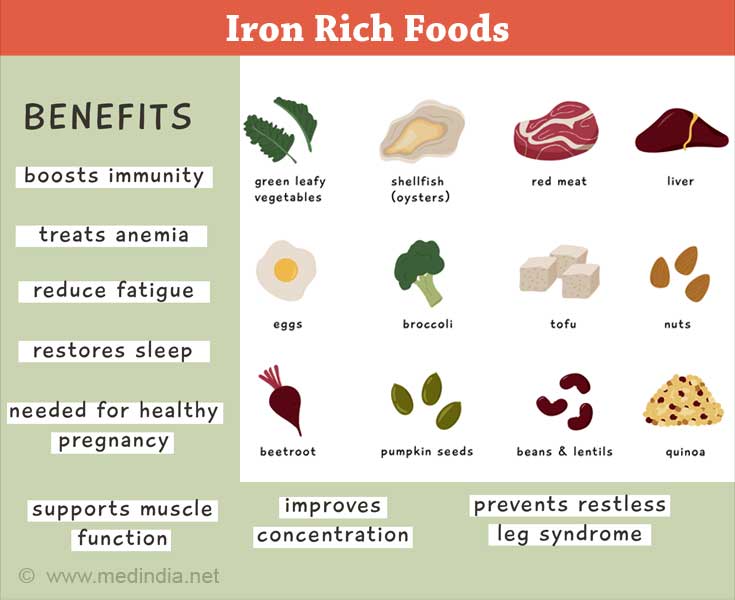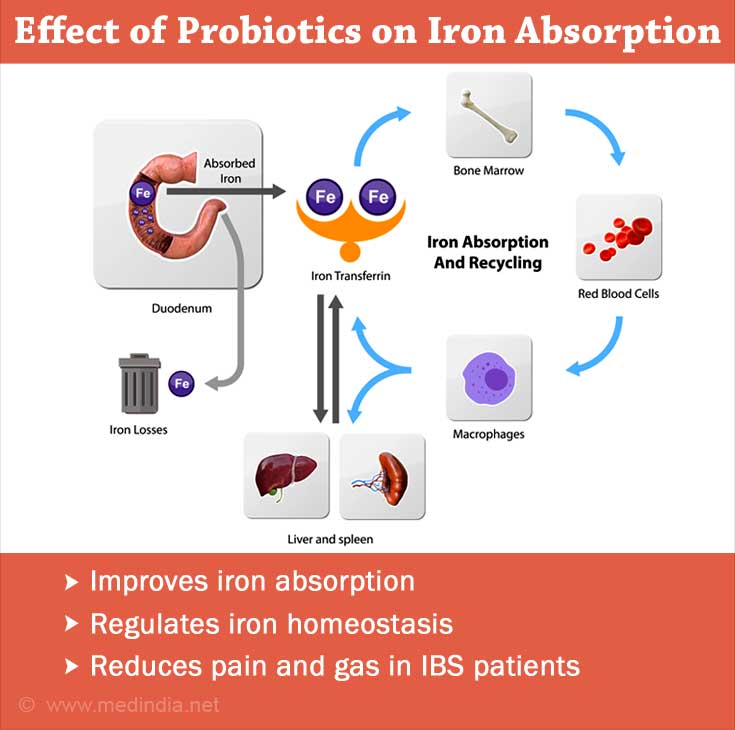- Vonderheid, S. C., Tussing-Humphreys, L., Park, C., Pauls, H., OjiNjideka Hemphill, N., LaBomascus, B., McLeod, A., &Koenig, M. D. (2019). A systematic review and meta-analysis on the effects of probiotic species on ironabsorption and iron status.Nutrients, 11(12), 2938 - (https://doi.org/10.3390/nu11122938)
- Hoppe, M., Önning, G., Berggren, A., &Hulthén, L. (2015). Probiotic strain Lactobacillus plantarum 299v increases iron absorption from an iron-supplemented fruit drink: A double-isotope cross-over single-blind study in women of reproductive age.British Journal of Nutrition,114(8), 1195–1202 - (https://doi.org/10.1017/S000711451500241X)
- Rusu, I. G., Suharoschi, R., Vodnar, D. C., Pop, C. R., Socaci, S. A., Vulturar, R., Istrati, M., Moroșan, I., Fărcaș, A. C., Kerezsi, A. D., Mureșan, C. I., &Pop, O. L. (2020). Iron supplementation influence on the gut microbiota and probiotic intake effect in irondeficiency—A literature-based review.Nutrients,12(7), 1993 - (https://doi.org/10.3390/nu12071993)
- Shi, L. H., Balakrishnan, K., Thiagarajah, K., Mohd Ismail, N. I., & Yin, O. S. (2016). Beneficial properties of probiotics.Tropical LifeSciences Research,27(2), 73–90 - (https://doi.org/10.21315/tlsr2016.27.2.6)
- Skrypnik, K., Bogdański, P., Schmidt, M., &Suliburska, J. (2019). The effect of multispecies probiotic supplementation on ironstatus in rats.Biological Trace Element Research,192(2), 234–243 - (https://doi.org/10.1007/s12011-019-1658-1)
Why Iron Deficiency is a Concern?
Iron is an essential mineral that carries out critical functions in the body. It is linked with oxygen transport in blood and muscle and its storage, hormone synthesis, transfer of electrons, DNA replication, red blood cell (RBC) production, fixation of nitrogen, controlling cell cycle, antioxidant functions, and many more. Deficiency and excess of iron (hemochromatosis) can portray detrimental effects on human health.
Iron deficiency is a global concern affecting more than two billion people across the world. World Health Organization (WHO) reports that almost half of the anemia cases are due to iron deficiency anemia (IDA). Iron deficiency resulting in anemia leads to low levels of oxygen in tissues and overall homeostasis. Pregnancy calls for additional iron requirements, but in many developing countries, more than 52 percent of pregnant women are iron deficient.
Iron can be found naturally in foods, in fortified food products, and as supplements. Iron supplementation is the common treatment for IDA. Fortification of iron is common in foods like cereals, milk products, sugar, salt, and condiments. However, cereals are rich in phytic acid content and their use as iron carriers is ineffectual.
Recent research has displayed that probiotic supplementation in iron-rich sources shows a positive effect in promoting absorption and in iron bioavailability.
What is the Link between Probiotics and Iron Bioavailability?
Probiotics are live microorganisms that render health benefits to the host when consumed in adequate amounts. Probiotics help improve gastrointestinal health, boost immunity, promote balance in gut microbiota, regulate cholesterol levels, maintain optimal blood glucose level and blood pressure, improve skin health, and many more. Probiotics also establish a bond with micronutrients and have been shown to help prevent and treat micronutrient deficiencies.
Iron bioavailability is the availability of iron in systemic circulation after absorption for physiological functioning. Factors that influence iron bioavailability could be inadequate iron intake, plant-based diet, gut health, and many more.
The iron in foods may be heme (ferrous form) or non-heme (ferric form) iron.
- Heme iron sources, including meat and its products, are found as ferrous iron and are absorbed directly.
- Non-heme iron sources like legumes and vegetables are reduced from their original ferric state to ferrous state for absorption.

Ferrous iron is the most bioavailable form of iron but most food sources of iron have low solubility (ferric iron). Therefore, only about 10 percent of dietary iron is absorbed and 90 percent of the iron is excreted in the feces.
To promote the absorption of iron — ascorbic acid, folic acid, vitamin A, probiotics, prebiotics, and fermented foods (like yogurt, kefir) have been useful.
Inhibitors to iron absorption are phytates, calcium, and polyphenols. Coffee and tea are rich in phytates and hence should be avoided with iron sources. Polyphenols like flavones, isoflavones, flavanones, isoflavonones, and anthocyanidins are inhibitors of iron. Alcohol intake can downturn ferrous iron absorption and augment ferric iron absorption.
Iron and Gut Health
Gut microbiota has a great impact on human health just the way iron has an impact on gut health. Gut health is influenced by dietary habits, drugs, stress, and many more.
Iron, either deficient or in excess due to malabsorption, can bring about alterations in the microbial ecosystem in the gastrointestinal tract. Proper intestinal levels of iron will abate the virulence and colonization of pathogenic microbes in the gut. Another important factor affecting iron absorption is the pH of the intestine. A decrease in pH caused by fermentation can boost iron absorption.
Inflammation in the gut can also alter the absorption of iron. Some microbes in the gut can stimulate the development of pathogens, causing inflammation which in turn retards iron absorption. Hence, a balanced, eubiotic gut microbiota will stimulate iron availability by decreasing the iron binders in the gut and by reducing ferric forms of iron to ferrous iron, the bioavailable form. This is where probiotics play a major role in promoting gut health and in augmenting iron bioavailability.
What are the Effects of Probiotics on Iron Absorption?
Lactic acid-producing bacteria, namely lactobacilli, have been shown to lower pH, produce organic acids, reduce inflammation, and activate phytases to absorb iron. Certain strains of probiotic bacteria have been studied of which, Lactobacillus plantarum showed a positive effect in iron absorption with its remarkable ferric-reducing activity. Lactobacillus plantarum improved iron absorption by 50 percent in iron-supplemented drinks.

A study conducted to evaluate the absorption of iron from an iron-supplemented fruit drink containing Lactobacillus plantarum 299v (Lp299v) strain reported that the iron absorption was higher than the control group. The mechanism of this beneficial effect includes the production of metabolites that promote ferric-reduction, the production of mucin at the intestine, thereby aiding enterocyte iron uptake, and regulating iron homeostasis with its anti-inflammatory activity. This strain was also reported to be effective in reducing the pain and gas in IBS patients, hindering pathogenic microbes in the gut, and in reducing inflammation.
Animal studies have reported that multispecies probiotic supplements showed to be favorable in iron absorption and bioavailability. Studies also demonstrated that prebiotics and probiotics or a symbiotic approach augmented iron absorption by stimulating enterocytes uptake and conversion of ferric iron to ferrous iron.
Synbiotics can also be used in type 2 diabetes individuals to promote iron absorption and prevent several metabolic complications that occur due to an imbalance in serum minerals.
Bottom Line
Microbiome therapy has become a popular treatment approach for several health conditions. Iron deficiency is a rising global problem commonly seen in children, women of reproductive age, and pregnant women.
The effective treatment approaches to combat iron deficiency are:
- consuming adequate iron-rich food sources
- iron fortification in foods, and
- iron supplements as drugs.
Adding to the list, probiotics too can help improve iron bioavailability and treat deficiency. Using probiotics along with iron-fortified foods can be less expensive, easily accessible, and reduce drug usage. Therefore, shining light on probiotics will be a rewarding clinical tool to encounter iron deficiency.






